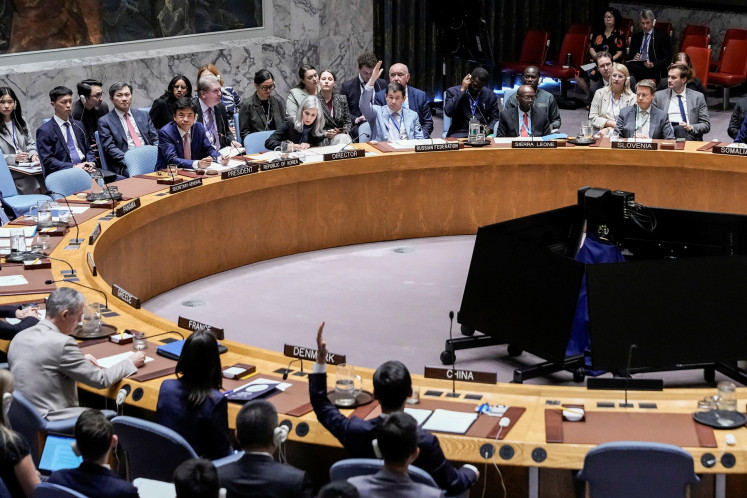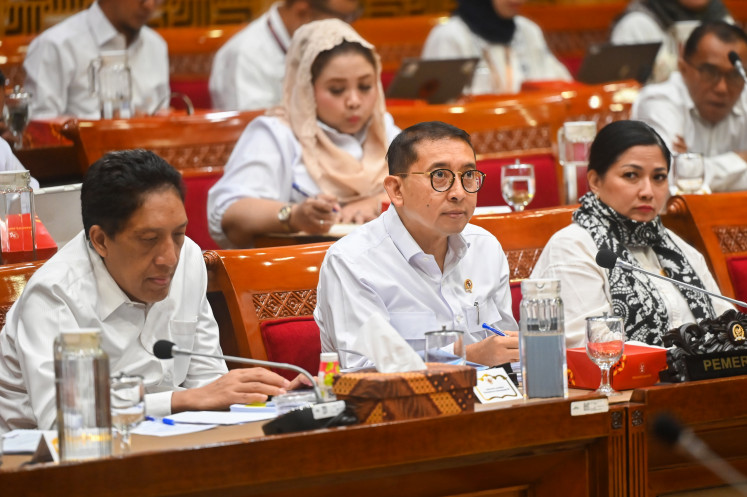Popular Reads
Top Results
Can't find what you're looking for?
View all search resultsPopular Reads
Top Results
Can't find what you're looking for?
View all search resultsRadio stations strive to attract younger audience
New dawn: Members of the national radio station Radio Republik Indonesia attend a ceremony marking the launch of the station’s nationally integrated newsroom, which incorporates the station’s efforts to digitally transform itself and win over a younger audience
Change text size
Gift Premium Articles
to Anyone
N
ew dawn: Members of the national radio station Radio Republik Indonesia attend a ceremony marking the launch of the station’s nationally integrated newsroom, which incorporates the station’s efforts to digitally transform itself and win over a younger audience. (Courtesy of Radio Republik Indonesia)
Wahyu Astuti noticed that her 16-year-old daughter, Michelle, was spending most of her free time on her phone. Michelle enjoys videos of K-pop dances, watch vlogs of stand-up comedian Raditya Dika or plays the songs of Disney’s megahit movie Frozen on YouTube.
With a phone and an internet connection, Michelle no longer needs to turn to old-school entertainment. “She hasn’t watched TV for seven years and she simply doesn’t listen to the radio,” Wahyu says.
She would have to ask her daughter to unplug her headset and listen to the radio instead. The fact that her daughter shows no interest in traditional radio is somehow unsettling for Wahyu, who works as the programming and content general manager at Sonora FM.
“My daughter is the closest way for me to observe what’s on the mind of the Gen Z,” she says.
As loyal listeners are aging, radio stations have to actively reach out and promote themselves to a younger audience.
For its long-term marketing strategy, Sonora — which offers pop music, news and talk shows for urbanites between 35 and 45 years old — must be aware of how to promote the brand to potential younger listeners in the age of music streaming and podcasts.
The disruption by the internet that Wahyu faces is also what other radio programmers are trying to address. Gone are the days when everyone scanned through the FM frequencies to discover new favorite stations.
Also, in the past few years, traditional radio stations have been gearing up to raise brand awareness: holding off-air events, interacting with listeners through social media accounts, uploading videos onto their YouTube channels and producing their own podcasts. Radio broadcasters know unique and relatable content, as well as a clear sense of radio identity, has become more crucial than ever.
Besides the emotional bond and exclusive content, many radio listeners still prefer the convenience of enjoying best-selling hits and getting news updates hand-picked by radio programmers. Thanks to the long commute and bad traffic in big cities, drivers turn on their car radios, or stream programs over their gadgets.
The sound of pop
Radio broadcasters on a shoestring budget learn to move slowly and carefully in adapting to fast-paced change, but deep-pocketed ones can spend money on continuous promotional campaigns. Indonesia’s pop radio giant Prambors, for instance, said that it has spent up to Rp 1 billion (US$71,982) for its promotional and marketing events to lure new listeners and retain their long-time ones, says Iqbal Tawakkal, the assistant brand manager at Prambors.
“The biggest chunk of our budget goes to our annual events, like Youth Fest,” he adds.
Prambors, among the biggest pop radio stations in the country, is also known for its generous giveaways to its listeners, which are affectionately called “kawula muda” (I’m young). To keep them excited and tuned into its programs, Prambors often holds giveaway contests, such as for concert tickets of global pop stars like Ed Sheeran and Shawn Mendes, travel packages to Japan or, even better, both flights and concert tickets, like going to see K-pop stars in Bangkok for free.
Iqbal says all of these programs have paid off; Prambors has maintained its unrivaled popularity among teens and young adults while still making a profit.
Subtle shifts
Radio stations are confident in their brand identity and eager to create a stronger impression to widen their markets. Among them is the news and talk radio station Elshinta FM, which strives to steadily improve its journalism, but at the same time tries to make a gradual change to appeal to new listeners.
The station is trying to walk a fine line by capturing a new segment of a younger audience without alienating its older listeners, says Haryo Ristamaji, the deputy chief editor at Elshinta.
In order to build a younger audience, Elshinta airs a one-hour session specifically designed for college-age listeners on the weekend. The station has also rebranded its talk show as an outlet for young people to hone their public speaking skills.
But making all young listeners feel at home doesn’t happen overnight. Adeline Prihandini, who studies visual communication design in her fifth semester, has been listening to Elshinta for the past year. The thought of calling the station and voicing her opinion has come to her mind, but she always hesitates. “I didn’t dare to join the discussion,” she says. “Many callers are pretty opinionated and could quickly engage in a heated discussion with the guest speakers.”
All of the radio stations where I did interviews claimed that the number of their FM radio listeners is growing and have become robust in the past few years, as reported by independent surveys. But none of them underestimates the digital disruptions. The internet has made the future of the FM radio look uncertain and even bleak.
“The digital disruption is really bugging us, to be honest,” says Wahyu of Sonora. The solution pursued is to post regular content to popular digital platforms, from uploading podcast episodes to Spotify and videos of on-air interviews on YouTube.
“We don’t see these digital platforms as our rivals,” says Wahyu. “It’s simply the place we must join today. We upload our content, so people can look it up and find us.”










